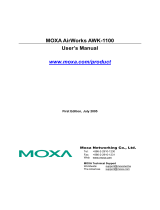
Contents
1 Introduction............................................................................................................................................ 1
1.1 Overview ........................................................................................................................................ 1
1.2 Features .......................................................................................................................................... 1
2 First-Time Installation and Configuration ............................................................................................. 2
2.1 Powering up the AP ........................................................................................................................ 2
2.2 Mounting the AP on a Wall ............................................................................................................ 2
2.3 Preparing for Configuration ........................................................................................................... 3
2.3.1 Connecting the Managing Computer and the Advanced AP .................................................. 3
2.3.2 Changing the TCP/IP Settings of the Managing Computer .................................................... 3
2.4 Configuring the Advanced AP ....................................................................................................... 4
2.4.1 Entering the User Name and Password ................................................................................... 4
2.4.2 Step 1: Configure TCP/IP Settings .........................................................................................5
2.4.3 Step 2: Configure IEEE 802.11 Settings ................................................................................. 6
2.4.4 Step 3: Review and Apply Settings.........................................................................................6
2.5 Deploying the Advanced AP .......................................................................................................... 7
2.6 Setting up Client Computers .......................................................................................................... 7
2.6.1 Configuring IEEE 802.11b-Related Settings .......................................................................... 7
2.6.2 Configuring TCP/IP-Related Settings ..................................................................................... 7
2.7 Confirming the Settings of the AP and Client Computers ............................................................. 7
2.7.1 Checking if the IEEE 802.11b-Related Settings Work ........................................................... 7
2.7.2 Checking if the TCP/IP-Related Settings Work ..................................................................... 8
3 Using the Web-Based Network Manager .............................................................................................. 9
3.1 Overview ........................................................................................................................................ 9
3.2 General Operations ....................................................................................................................... 11
3.2.1 Changing Password ............................................................................................................... 11
3.2.2 Upgrading Firmware ............................................................................................................. 11
3.3 Configuring TCP/IP Related Settings .......................................................................................... 12
3.3.1 Addressing ............................................................................................................................ 12
3.4 Configuring IEEE 802.11b-Related Settings ............................................................................... 13
3.4.1 Communication ..................................................................................................................... 13
3.4.2 Security ................................................................................................................................. 13
3.4.3 IEEE 802.1x/RADIUS ....................................................................................................... ... 14
3.5 Configuring Advanced Settings ................................................................................................... 16
3.5.1 Management .......................................................................................................................... 16
4 The Wireless Network Manager .......................................................................................................... 16
4.1 Installing the Wireless Network Manager .................................................................................... 16
4.2 Using the Wireless Network Manager ......................................................................................... 18
Appendix A ................................................................................................................................................. 20
A-1: Default Settings ............................................................................................................................... 20
A-2: LED Definitions .............................................................................................................................. 20
Appendix B: Troubleshooting ..................................................................................................................... 21
B-1: Wireless Settings Problems ............................................................................................................. 21
B-2: TCP/IP Settings Problems ............................................................................................................... 21
B-3: Other Problems ................................................................................................................................ 23
100-408-01 Copyright © 2002 Madge Networks. All rights reserved. Page iii






















